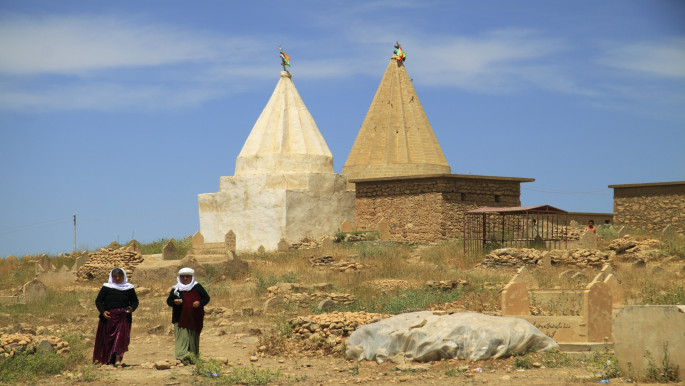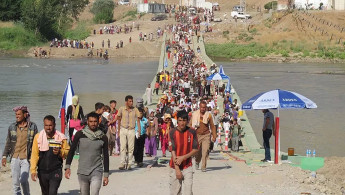The tragedy of Mount Sinjar
On their way up Mount Sinjar in northern Iraq, Yazidi refugees dig their children’s graves with their bare hands. Many youngsters have died of hunger and thirst while escaping militants from the Islamic State group (IS, formerly known as ISIS). Many more are waiting to die.
After the Yazidis fled their villages in northern Iraq, US media showed food aid being dropped from military jets to those trapped on the mountain. However, investigations by al-Araby al-Jadeed have shown that most of this aid did not reach those who needed it.
We travelled to Mount Sinjar accompanied by the Kurdish People’s Protection Units, part of the peshmerga, who were helping those trapped there.
| Many youngsters have died of hunger and thirst… Many more are waiting to die |
During the two-day journey we travelled by car and walked across difficult terrain before reaching the refugees who were caught between IS group fighters and hunger, thirst, disease and bad weather.
As we climbed the mountain, Bashar al-Hasaki and his group of Syrian Kurdish fighters affiliated with Syria’s Kurdish Democratic Union Party (PYD) stopped us. They were using the road along the Syrian-Iraqi border to escort refugee groups to Derek, a city in north-east Syria under Kurdish control. When they arrive in Derek, they are divided into two groups: one goes to the Nowruz refugee camp in the suburbs of the Syrian city of al-Hasakah, and the other to Zakho, a city in the Kurdistan governorate of Dohuk in northern Iraq - both areas under Kurdish control.
Crossing the border
Along the dusty road penetrating the Iraqi-Syrian border a long line of Yazidis, many sick and suffering from severe dehydration, were dragging their feet under the scorching sun and strong dusty winds. Those needing urgent medical assistance looked for transport. “The lucky ones find rides in pick-up trucks, tractors, or even on construction cranes,” said Hasaki.
On reaching the foot of the mountain in northern Iraq we saw even more painful scenes. There were refugees who had not eaten real food for ten days or more, and who had been sharing a drop of water to survive. Hasaki said no one would believe the stories of the women and children who had died on Mount Sinjar.
We reached our first refugee evacuation point from Mount Sinjar. It was an area of extremely rough terrain in a state of pandemonium. The screams of children mingled with the voices of Kurdish fighters organising basic humanitarian aid before the refugees’ journey into Syria. It was here Hasaki’s mission ended. Before saying goodbye he asked people in the area to help us travel further up the mountain.
Starving in the sun
After hours of difficult walking we reached our first refugees. A group of men who had chosen to stay lower down the mountain, while the women and children moved to a higher part for safety.
Our new guide, a young Yazidi man named Barakat Shakouli, introduced us to a middle-aged man in shabby clothes with an old Kalashnikov rifle on his shoulder.
“My name is Akram Chenkali,” said the gunslinger. “I am coordinating between refugees on the mountain and Syrian and Turkish fighters. The fighters are evacuating people from the mountain in coordination with Kurdish Pershmerga forces, who are distracting IS militants by fighting them at the foot of the mountain.”
 |
|
| [Getty] |
Chenkali’s words were replaced with tears as he guided us to the place where children that had died from hunger and thirst over the past few days were buried. “More than 50 graves have been dug and the bodies were quickly buried. Each grave is marked only with a rock,” he told us.
A refugee nearby showed us his starving body covered almost entirely in blisters from the sun. He had been eating leaves and grass until Kurdish fighters had arrived.
“During the past few days we were on a higher part on the mountain where we saw many tragic deaths, especially of children. A pregnant women died trying to reach the summit while escaping IS militants,” Chenkali added. “The refugees suffer most at night, when you can hear children crying from hunger and thirst. All we do during the day is bury the dead and search for plants to eat.”
Aid inaccessible
Chenkali and other refugees said that most of the aid dropped by US, British and Iraqi aircrafts was useless because it fell in hard-to-reach valleys. Many water containers - dropped from high altitude so as to avoid IS anti-aircraft fire – smashed upon impact with the ground.
One of Chenkali’s helpers, Khairy Memo, estimated that 1,000 people remained trapped on the northern part of the mountain, and more than 25,000 on the southern part, as well as those still in the city of Sinjar. He said no one knew how many had died from being executed, disease, starvation or lack of medicine, but witnesses estimated at least 1,100. Memo explained that although many refugees had already been evacuated, the rescue operation needed to speed up because people were dying, and women and children should be prioritised.
Chenkali advised us to leave with the last convoy that day because it was unsafe, especially at night. We travelled to Dohuk accompanied by a group of Yazidis along a route secured by Peshmerga forces.
In Dohuk governorate, local authorities and Kurdish and UN relief organisations have worked tirelessly to help 100,000 Yazidis, and large numbers of displaced Christians and Arabs who have fled to the city. In an interview with al-Araby al-Jadeed the governor, Farhad al-Atrouchi, asked the central government in Baghdad for resources and help. He said that hundreds of schools and other buildings were being used to house families, but that many had to sleep in streets and parks because there was not enough shelter.
Yazidi writer Khader Khalat Bahzani was grief-stricken and angry as he talked about the tragedies his people had suffered since the IS group attacked their villages. He said that international community help was needed to protect their ancient culture. Bahzani explained that Yazidi was a Sumerian word that means “unpolluted” or “pure”, and that there have been 72 genocides in the Yazidi’s history. The attack on Sinjar is considered to be number 73 - and the most bloody yet.
Narine Shamo, a Yazidi television presenter and activist, found it difficult to describe what has happened. She argued that women in particular have suffered from crimes such as rape, trafficking and forced marriages - as well as murder. Not to mention mothers who have been forced to watch their children dying in front of their eyes.
Despite witnessing many humanitarian crises throughout her career, Shamo said the Sinjar disaster remains the worst. She will never get over the story of the Yazidi woman who had to leave her crying child dying on the mountain, bleeding from his mouth from dehydration. Shamo’s voice shook and her words mixed with tears, and we had to stop talking about the ongoing suffering of her people.
This article is an edited translation from our Arabic edition.



